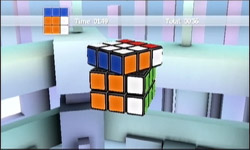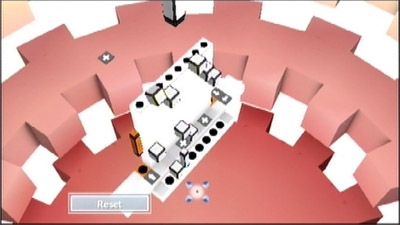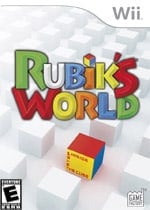It’s been decades since Rubik’s Cubes took the world by storm, but to this day, they’re a far from uncommon sight in households worldwide. Hoping to capitalize on the puzzle’s familiarity, developer Two Tribes and publisher The Game Factory recently brought Rubik’s World to the Wii.

If you want, you can use Rubik’s World to solve the famous twistable-square conundrum. It’s surprisingly easy to manipulate the cube with the Wii-mote; the physical cube feels more natural, but in the game, it’s never frustrating to grab a row and twist it with the pointer. You can move the camera with the Nunchuk joystick or by pointing the Wii-mote at the screen, pinching the A and B buttons, and pulling the view wherever you want. If the standard three-by-three sides are too easy or too hard to make solid colors out of, you can solve cubes of three other sizes. Still not enough? Start with a solved cube and match it to a scrambled one the game provides. There’s even a complicated tutorial on Rubik’s Cube techniques.
Few people will buy a $40 video game to play with a $10 cube, though. Most players will spend their time in the seven other areas, which are populated by “cubies,” or the little cubes of various colors that make up the Rubik’s Cube. These game modes unlock quickly as you work your way through them, and they’re a mixed bag: two are brilliant, two are annoying, one is uninventive, and the last two are whatever you make of them.
Hands-down, “Guide” is the best part of Rubik’s World. Each puzzle in this area takes place on a three-dimensional grid landscape. Several colored spawners spit out cubies, which roll end-over-end in a given direction, and for each color, there’s at least one recepticle. Your job is to place arrows in the cubies’ paths directing them from their spawners to their recepticles. You have to keep adjusting your signs until they can make it to safety without touching each other or falling off the edge.

It’s a simple concept, and the first few solutions should be glaringly obvious to anyone with a double-digit IQ, but the puzzles get complicated in a hurry. The level design is ingenious, rarely giving you more signs than you absolutely need, and some of the trickiest levels are the simplest-looking. Some signs speed up or slow down the cubies, and a triangle sign splits them up, sending the first cubie right, the second left, the third right, and so on.
You can work out most of the puzzles with some time, serious thought, and persistence, but a few are maddeningly difficult, especially the ones that require adjusting the cubies’ speed. At first, we weren’t convinced that the final two puzzles were even possible (some time later, it turned out they were).

“View” mode is also terrific, if a little less addictive. Here, you have a big, clear, empty cube you can fill with cubies. The goal is to make three sides of the cube look like the three pictures the game gives you; the catch is that you’re limited in how many cubies you can use, and because the big cube is (of course) three-dimensional, every time you make a change to one side, you have to think about how it affects the others. As in “Guide” mode, the puzzles are clever and challenging.
In “Switch” mode, the puzzles are still challenging, but far less clever. This is a standard “put blocks of a like color together and they disappear” game. This is worthwhile for diehard puzzle fans only.
“Fit” and “Deconstruct” might be too much for even the diehards, though they’re the game’s only multiplayer modes (up to four players, only one Wii-mote necessary). In the former, each puzzle has some cubies, some platforms, and a colored wall in the foreground. In the background is a wall with some parts cut out of it. The goal is to arrange the cubies, sometimes by smashing them into the colored wall to flatten them, so they’re all in front of the holes in the background wall. Then you press the B button. This brings the background wall forward, and if the cubies are placed properly, the next puzzle comes up. If you didn’t place the cubies correctly, the wall will knock them to the floor, and it’s game over.
There are a few problems with “Fit.” One is that many of the puzzles require you to hold cubies in the air with the Wii-mote pointer while pressing the B button, and keeping them steady is a bit tough (it gets easier the closer you stand to the screen). Also, you have to beat several puzzles in sequence to complete a level, so if there’s a particularly tough one toward the end, you have to keep beating the early ones. Finally, the levels are timed, meaning sometimes you have to rush, exacerbating the above issues. (It’s more manageable if another player helps you in co-op.)

In “Deconstruct,” your job is to shoot white cubies at stacks of other cubies; the goal is to knock down ones that give you points and avoid the ones that take points away. When you can’t beat a level, it’s hard to tell what you’re doing wrong, and all in all it’s a little on the boring side. There is a competitive two-player mode, though.
The final two modes are simple playgrounds with no goals or puzzles. In “Create,” you can build whatever you want with cubies, and when you save your creations, sometimes they pop up in the other areas. A nice touch, but nothing most people will spend much time with.
“Compose,” meanwhile, allows you to “teach the cubies” songs. When you win or lose a puzzle, the game will play the compositions you save in the first and second save slots respectively, and there are a few other save slots in which you’re free to mess around. It’s mildly amusing to someone with basic knowledge of music theory (you play the notes on a keyboard with the Wii-mote), but each instrument only has a one-octave range, so it’s not a tool for creating the next great symphony.
From a technical standpoint, this game is pleasant but far from impressive. It’s colorful, and the intricate 3-D puzzles are easy to analyze in detail. The sound effects are cute, but the music gets a bit repetitive, even when you add your own. The controls work for the most part; you can play with or without the Nunchuk, and the only problem we encountered was that sometimes it’s too easy to put a “Guide” sign or “View” cubie in the wrong place by accident.
For puzzle fans, this is definitely an experience worth having. The puzzle modes have 32 to 44 levels each, many of them quite difficult, and “Guide” mode in particular is a whole lot of fun. However, there’s no point in beating the same level twice, and the “Create” and “Compose” modes aren’t captivating enough to add much replayability, so this is a game to rent, not buy.
RATING OUT OF 5 RATING DESCRIPTION 2.8 Graphics
It’s nothing to write home about, but it gets the job done. 3.6 Control
Sometimes it’s easy to misplace things with the Wii-mote pointer, but by and large everything works correctly. Comfortable to play with and without the Nunchuk. 3.0 Music / Sound FX / Voice Acting
The sound effects are cute, and you can make your own music, but there’s a lot of repetition. 4.2
Play Value
Two of the modes, “Guide” especially, are brilliantly constructed, challenging, and impossible to put down. They easily make up for the lackluster other modes and lack of replayability, assuming you’re renting and not buying.
3.8 Overall Rating – Good
Not an average. See Rating legend above for a final score breakdown.
Game Features:
